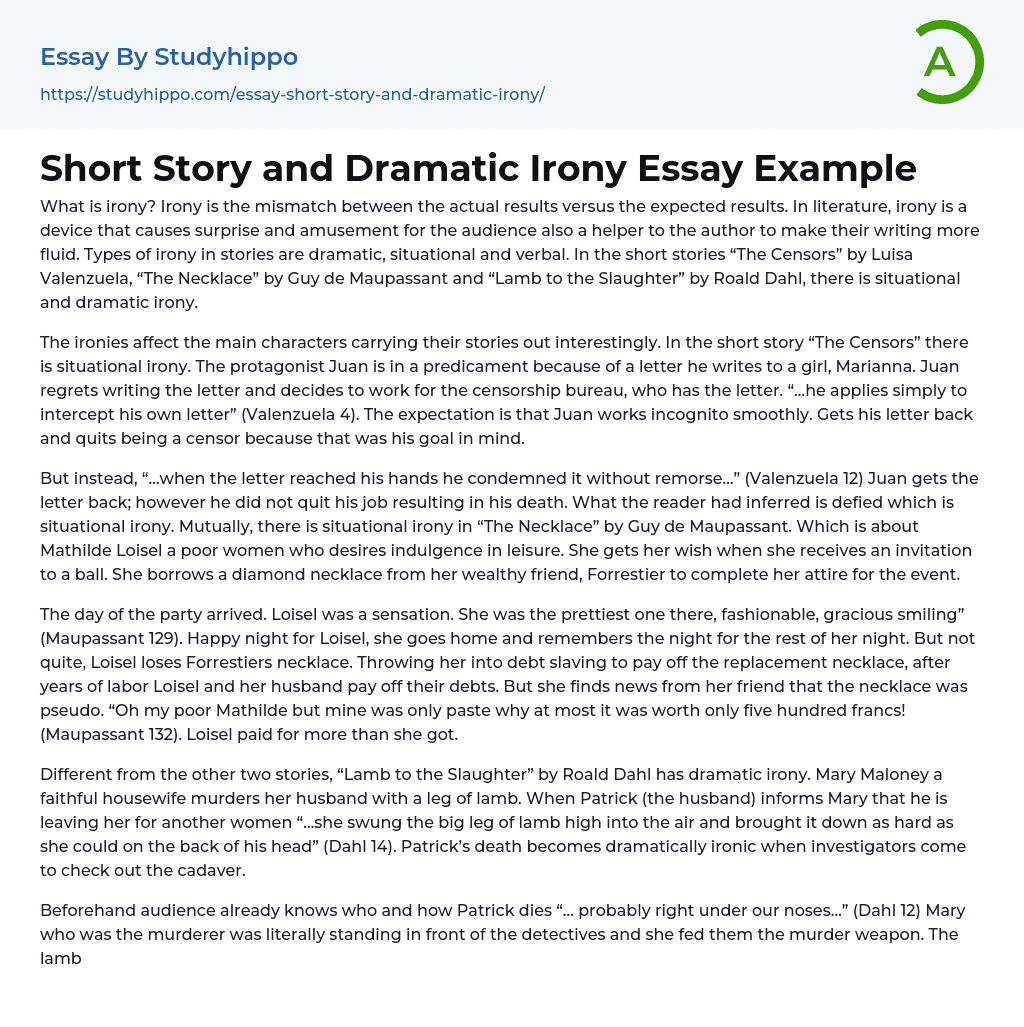What is irony? Irony is the mismatch between the actual results versus the expected results. In literature, irony is a device that causes surprise and amusement for the audience also a helper to the author to make their writing more fluid. Types of irony in stories are dramatic, situational and verbal. In the short stories “The Censors” by Luisa Valenzuela, “The Necklace” by Guy de Maupassant and “Lamb to the Slaughter” by Roald Dahl, there is situational and dramatic irony.
The ironies affect the main characters carrying their stories out interestingly. In the short story “The Censors” there is situational irony. The protagonist Juan is in a predicament because of a letter he writes to a girl, Marianna. Juan regrets writing the letter and decides to work for the censorship bureau, who has the l
...etter. “…he applies simply to intercept his own letter” (Valenzuela 4). The expectation is that Juan works incognito smoothly. Gets his letter back and quits being a censor because that was his goal in mind.
But instead, “…when the letter reached his hands he condemned it without remorse…” (Valenzuela 12) Juan gets the letter back; however he did not quit his job resulting in his death. What the reader had inferred is defied which is situational irony. Mutually, there is situational irony in “The Necklace” by Guy de Maupassant. Which is about Mathilde Loisel a poor women who desires indulgence in leisure. She gets her wish when she receives an invitation to a ball. She borrows a diamond necklace from her wealthy friend, Forrestier to complete her attire for the event.
The day of the party
arrived. Loisel was a sensation. She was the prettiest one there, fashionable, gracious smiling” (Maupassant 129). Happy night for Loisel, she goes home and remembers the night for the rest of her night. But not quite, Loisel loses Forrestiers necklace. Throwing her into debt slaving to pay off the replacement necklace, after years of labor Loisel and her husband pay off their debts. But she finds news from her friend that the necklace was pseudo. “Oh my poor Mathilde but mine was only paste why at most it was worth only five hundred francs! (Maupassant 132). Loisel paid for more than she got.
Different from the other two stories, “Lamb to the Slaughter” by Roald Dahl has dramatic irony. Mary Maloney a faithful housewife murders her husband with a leg of lamb. When Patrick (the husband) informs Mary that he is leaving her for another women “…she swung the big leg of lamb high into the air and brought it down as hard as she could on the back of his head” (Dahl 14). Patrick’s death becomes dramatically ironic when investigators come to check out the cadaver.
Beforehand audience already knows who and how Patrick dies “… probably right under our noses…” (Dahl 12) Mary who was the murderer was literally standing in front of the detectives and she fed them the murder weapon. The lamb was on their plates, under their noses. The presence of situational and dramatic irony not only made the short stories more enter -taining but helped chain together the events that went on in the stories. The ironies antagonized the cliche “happily ever after”. Readers may find the
stories more interesting when what they expect is opposed.
- Book Summary essays
- Metaphor essays
- Reader essays
- Rhyme essays
- Literary devices essays
- Villain essays
- Books essays
- Genre essays
- Literary Criticism essays
- Writer essays
- Protagonist essays
- Simile essays
- Poem essays
- Book Report essays
- Book Review essays
- Greek Mythology essays
- Plot essays
- Tragic Hero essays
- Coming of Age essays
- Play essays
- Rhetoric essays
- Rhetorical Question essays
- Translation essays
- Understanding essays
- Reason essays
- Character essays
- Letter essays
- American Literature essays
- Literature Review essays
- Utopia essays
- Poetry Analysis essays
- Dante's Inferno essays
- Between The World and Me essays
- Incidents in The Life of a Slave Girl essays
- Flowers for Algernon essays
- Myth essays
- Everyday Use essays
- Boo Radley essays
- Genesis essays
- Richard iii essays
- Alice in Wonderland essays
- On the road essays
- Ozymandias essays
- The Nightingale essays
- Holden Caulfield essays
- Animal Farm essays
- 1984 essays
- A Hanging essays
- Shooting An Elephant essays
- A Tale Of Two Cities essays




